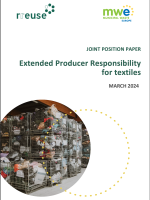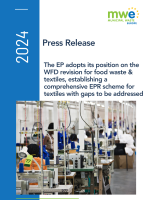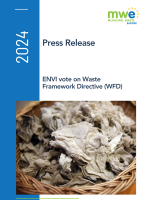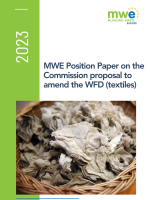Response to the Call for Evidence for an Impact Assessment for the Revision of EU Waste Framework
Municipal Waste Europe welcomes the direction towards Climate Change Mitigation put forward by the European Green Deal and the Circular Economy Action Plan 2.0, both launched in 2020. Since then we have followed and given feedback to the large number of legislative and non-legislative initiatives related directly and indirectly to waste management that have been developed by the European Commission. At this point we find it important to highlight the need to adapt product legislation to ensure that it is integrated seamlessly with waste legislation, thereby supporting and promoting a Circular Economy. The best collection, sorting and recycling systems will not succeed in creating a Circular Economy if product design and consumption models are not designed for circularity. Waste Prevention, Reusability and Recyclability are not issues that can be solved in the waste phase; the product, its longevity, reparability and recyclability are all functions of its design. Moreover, most EU Member States are still dealing with the challenges presented by implementation of the previous revisions Waste Framework Directive, as proved by the set of letters of formal notice submitted by the Commission by end of last year. Despite efforts to reduce it, waste generation is still growing in the EU and many countries have failed to achieve the recycling and other targets. In this context, MWE calls the Commission for further efforts on monitoring and providing the assistance needed to Member States for the efficient transposition of this legislation. MWE also calls the Commission to avoid overreliance on targets held by the waste sector, but to introduce intended measures on ecodesign and promotion of waste prevention. Municipal Waste Europe is willing to share our members’ expertise and contribute to the next revision of the Waste Framework Directive. In this light we raise the following key issues which need to be addressed in the next revision:
Waste Prevention
MWE welcomes further efforts on the full implementation of the waste prevention provisions and on the promotion of Member States’ Waste Prevention Programmes. Further assistance and guidance to Member States, as laid down in Art. 29 (5) of the WFD is much needed. Rue d’Arlon 63, B-1040, Brussels - Tel: +32 2 400 10 94 Web: www.municipalwasteeurope.eu 2 We particularly welcome the Commission’s efforts on addressing food waste prevention but would like to recall that focus is especially needed on e-waste, textile waste and bulky waste both from the perspective of repair and reuse and to eliminate illegal shipments.
Bulky Waste
A significant omission in the 'Call for Evidence for an Impact Assessment' is attention to bulky waste. In the WFD currently in force, bulky waste is barely defined or considered whereas it represents a significant percentage of municipal waste, the principal source of waste for reuse and when not separately collected or treated, a significant percentage of landfilled waste. It is an area that MWE members expect to see addressed in this current revision. We particularly refer to wood, furniture and mattresses.
The composition and amount of bulky waste may vary across the EU, as it depends on consumer behaviours and socio-economic aspects (e.g. higher or lower tendency to do domestic renovations) and the overall waste management structure itself (e.g. bin sizes, available space and acceptance criteria at the civic amenity sites). However, data reveals that there is still an untapped potential in bulky waste to boost waste prevention through preparation-for-reuse and reuse. By way of example, the municipality of Kristianstad (Scania, Sweden, 86,000 inhabitants) alone received 15,760 tonnes of bulky waste (7,610 tonnes with garden waste excluded) out of a total of 42,390 tonnes of municipal waste in its civic amenity sites in 2019. This is equal to 37% of the municipal waste generated. A study from Avfall Sverige in 20181 ("picking analyses") showed that as much as 18% by weight of the bulky waste consisted of products with a sufficiently high resale value to be able to be reused commercially, at a flea market or in a traditional second-hand shop. This shows that more incentives are needed higher up in the waste hierarchy in order to increase waste prevention and re-use concerning bulky waste.
This is not an isolated case in the EU. The trend is the same in Norway. An assessment by Miljødirektoratet suggests a potential of 80,000 tonnes of bulky waste from households alone that could be reused. Furniture from public sector is also an untapped potential estimated to 15,000 tonnes.
In The Netherlands about 30% of household waste is considered bulky waste. And in Vienna (Austria) approximately 8-10% of the mixed municipal waste can be considered as bulky waste as well. Further, an analysis of bulky waste in Vienna last year led to following results: aprox. 50% wood for energy recovery, 20% upholstered furniture, 10% wood for recycling, 9% home textiles and mattresses, 1% Rue d'Arlon 63, B-1040, Brussels - Tel: +32 2 400 10 94 Web: www.municipalwasteeurope.eu 3 metals, 10% other. MWE welcomes the fact that textiles are already in the Commission's agenda, however, wood, furniture and mattresses are still out of the European discussion.
If the Commission is determined to decrease EU waste generation, residual waste and landfill, addressing bulky waste will be very effective. However, as bulky waste is a part of municipal waste, we believe that it is already covered by the targets for municipal waste. Having said that, setting requirements for separate collection of bulky waste at civic amenity sites could possibly be considered. At this stage, MWE calls on the European Commission to analyses the state-of-play of bulky waste in the EU and consider further assistance to Member States on waste prevention and recycling solutions for bulky waste (furniture, wood and mattresses).
Preparation-for-reuse, reuse and recycling
The existing definitions of reuse and preparing-for-reuse should be reconsidered in order to make both definitions more coherent with each other. While reuse refers to products and components that have not become waste, preparing-for-reuse solely refers to the preparation of wasted products and components for being re-used afterwards.
In terms of targets, MWE calls on the Commission to establish separate targets for the preparation-for-reuse and recycling. Targets for preparation-for-reuse must be relevant to the local (municipal) generation of bulky waste and use simple, specific and measurable indicators to enable calculation of the target and implementation of the measure. In MWE's opinion, separating the preparation for reuse and recycling targets will incentivise and facilitate the prevention of residual waste.
Yet, it is important to mention that MWE does not recommend targets for reuse as this would actually bring practical unfeasibility and failure rather than a significant step towards waste prevention. The same obligations for separate collection as well as targets for reuse and recycling must be applied to Commerce and Industry including Construction in the ongoing revision. Municipal Waste is only 10% of total waste generation in any country therefore addressing only Municipal Waste in the EU Waste Framework Directive is to ignore up to 90% of waste.
Recycling: Targets, Calculation methodology, recycling hierarchy & data collection
At this stage, it is too soon to determine if the calculation methodology defined in the current version of the WFD is really helpful or there is need for an update. Some Member States are still working on collecting their first data using this calculation method so there is insufficient information as yet to perform an analysis of whether it is performing its intended function or not.
The WFD does not address 'high quality recycling', nor does it require proof of recycling from the recycling plant to the originator (collector? sorting plant?) of the waste. Linking the WFD to the WSR in this case is of utmost importance for intra-MS, intra-EU and extra-EU shipments and transfers to avoid 'disappearances' of separately collected waste, mostly caused by untraceable brokers and dealers. The quality of recycling is important; this should be addressed in the revision of the WFD and should be based on the concept of cascading. This should include the promotion of 'like to like' recycling and avoid e.g. PET/PE from packaging from being bought up by the textiles industry to produce fast fashion or carpets thereby making it unavailable to the packaging industry.
Data collection and transparency on behalf of all the actors involved in the value chain is a big issue for several Member States. The WFD should take inspiration from those Member States that already have a functioning obligation to report the real recycled quantities back to Municipalities and make a proposal for this to be the case EU wide. This also needs to be applied for Commercial and Industrial Waste whereby both the waste generator and the Competent Authority receive data on the actually recycled quantities directly from the recycling plant.
Landfill, biowaste & residual waste
The next revision of the WFD (and of the Landfill Directive) should set a landfill ban for both untreated biowaste and treated biowaste (resulting from Mechanical Biological or other similar treatment).
This ban is already established in several EU countries either integrated together with other waste materials with calorific value or isolated. This landfill ban on biowaste would incentivise more efficient separate collection of biowaste for recovery, while reducing methane emissions in landfills and thus contributing to the Carbon Neutral goal. This ban has already proved to be a helpful legal tool, for instance, in Germany, Norway and Sweden.
In Germany, the landfilling of untreated and biodegradable municipal waste was banned in 2005. By 2015, this landfill ban in Germany had already led to the avoidance of direct methane emissions from landfills with a climate-damaging effect of around 30 million tonnes of CO2equ per year. This is equivalent to a reduction of 70 to 80% compared to the reference year 1990. In Norway, there has been a landfill ban on biodegradable waste since 2009, as a consequence it is not possible in practice to landfill unsorted waste (even though there is no ban on this). Thanks to that, the emissions from landfilling has been reduced 2 million tonnes CO2 in 1990 to 1,2 million tonnes in 2013 (link). And, in Sweden there has been a ban in place since early 2000 on the landfilling of combustible waste. Both the ban on landfilling of organic and combustible waste has led to a figure of less than 1% of the municipal waste being landfilled.
In Finland and Austria there is a landfill ban on biowaste and combustible waste that contain more that 10% (in the case of Finland) and 5% (in the case of Austria) of carbon calculated as TOC/total organic carbon. This includes wood, paper and plastics. Denmark and The Netherlands have also a ban on landfilling of combustible waste.
A ban on landfilling of untreated household waste would also incentivise the preferable options established by the waste hierarchy. Landfilling untreated waste is not allowed in Germany (just mentioned above), Denmark, Italy and Portugal. Particularly, in Portugal and Italy there is a landfill ban on separately collected waste, only allowed in justified cases.
Harmonisation of waste collection systems and labelling
In 2020 the European Green Deal launched an initiative of paramount importance for municipalities: a proposal for a harmonisation of separate waste collection systems. The initiative seeks to contribute to increasing the quantity and quality of waste materials collected while helping citizens to play their part in efficient recycling. However, MWE is concerned about the reach of this 'harmonisation' at EU level as to go further than harmonised labelling which needs to be applied to both products and waste containers, would be counterproductive. Bin colours, logistics and other waste collection decisions are always subject to the local situation and experience demonstrates that they are tailored to each locality. The EU level, even the national level is too distanced from local realities for any harmonisation to be effective. Continuity in the waste management system and communication with waste generators to ensure their understanding is paramount to its success. Introducing repeated and dramatic changes to separate collection systems can undo previous successes by discouraging the waste holders. MWE also argues that any attempt to go beyond harmonised labelling at EU level would not be in line with the subsidiarity principle.
Municipal waste management is a complex and very local issue. Even though efficient waste collection is a key performance indicator in the achievement of a circular economy, local aspects mould what 'optimal' means in practice.
The 'Call for Evidence for an Impact Assessment' suggests that the Commission is considering introducing 'minimum requirements for source segregation and separate collection of waste that facilitates separate collection of used items for re-use and preparation for re-use'. MWE supports efforts to promote reuse and looks forward to contributing to this discussion.
MWE is an active participant in the ongoing study carried out by the Joint Research Centre with regard to this Commission initiative. In this context, we believe that the outcome of this study should translate into recommendations and guidance rather than legislation.
To implement the Green Deal's requirement for harmonisation of separate collection systems, MWE supports the further discussion of the Nordic Pictogram System as the model for an EU-wide harmonised labelling system for products and separate waste collection systems. This is a free, voluntary system that is already being used in all Nordic countries and the Baltic countries, Portugal and non-EU countries are looking at it with interest. It was first implemented in Denmark in 2018 and other Nordic countries began implementation in 2021. Reactions from municipalities, citizens and producers on its use are very positive to date however it is too soon to have collected any reliable data on its effects on quantities and the quality of the waste collected.
"Boosting secondary raw material market"
A good separate collection (in quantitative and qualitative terms) and an adequate capacity of recycling, recovery and disposal facilities, are absolutely necessary but not sufficient conditions to close the waste management cycle. The "loop" can only be closed with the return into the production cycles of the material and energy resources present in the waste. Without an adequate demand for secondary raw materials and products obtained from waste recovery, the transition to the circular economy risks not being completed, compromising the great transformation effort of the European industry of waste management. The revision of EU WFD must include measures to support the demand for secondary raw materials.
Extended Producer Responsibility
Extended Producer Responsibility (EPR) schemes are policy tools more and more used by Member States to finance the collection, sorting and recycling of waste. MWE would like underline that no EPR scheme must be established without collaboration with municipalities and other parties involved.
When an EPR scheme is established in a country and in order to completely fulfil the 'Polluter-Pays' Principle, MWE calls on the Commission to revise the WFD by setting out 100% coverage of the cost for collection and treatment of their waste products. This would incentivise that only repairable, reusable and recyclable materials are put on the market. Very importantly, municipal waste collection must be an operational responsibility held by municipalities, given that local public authorities are the closest actor to the citizens and knows well the local challenges.
Take-back systems: Concerns on transparency, hierarchy and over-consumption
It is also noteworthy to underline that the cost coverage should not only cover separately collected material and their treatment, but also the share that remains in the residual waste bin, as producers should take their responsibility regardless if their products are separately collected or not once become waste. This would create incentives for them to go beyond legal targets and to constantly improve collection rates. The 'Polluter-Pays' Principle can only be delivered when producers are fully responsible for the total cost. Otherwise EPR remains a dual concept.
Furthermore, while recognising that design for recycling is still underdeveloped in the EU and worldwide, EPR schemes tend to unfortunately drive their resources and efforts to mainly recycling, limiting their action to incorporate waste prevention in their strategies. This is, for example, the case for textile waste, acknowledged by the 'Study on the technical, regulatory, economic and environmental effectiveness of textile fibres recycling' (January, 2022), commissioned by DG GROW. This is a missed opportunity to enhance waste prevention measures. MWE members support the use of eco-modulation of fees to make non-repairable/reusable and non-recyclable materials and products unattractively expensive to the producer and thereby promote design for reuse and recycling. EPR discussions still centre around packaging however the other, more complex product/waste streams should not be forgotten, e.g. WEEE, batteries and soon textiles. As well as addressing prevention in product legislation, a disincentive to placing non-circular products or materials on the market should be included in an extension of the eco-modulation of fees in the ongoing revision of the WFD.
Last but not least, MWE eagerly awaits the expected Commission's guidance on litter clean-up costs and EPR, which are much needed to assist EU Member States on the implementation on the WFD. For more details on how to well-design an EPR scheme, we would like to refer to MWE's position paper on Extended Producer Responsibility published in 2013 and MWE's position on EPR for textiles published in 2021.
Take-back systems: Concerns on transparency, hierarchy and over-consumption
A take-back system is one of the existing channels of waste collection, particularly established for ewaste, batteries and clothing in the EU. Take-back systems are often operationally and financially controlled by retailers and manufacturers and consist of getting the product back from the consumer at the end of the life of such a product.
In principle, take-back systems are intended to contribute to a circular economy and achieve EU goals on recycling. However, MWE identifies a common lack of transparency on data of the material collected across the EU, in particular when it comes to take-back systems for textiles. For this reason, MWE calls on the European Commission to include a legal obligation in the revised WFD for producers and retailers to ensure transparency of data reporting to public authorities on the type, volume and fate of the material collected through take-back systems.
In addition to this, if a take-back system is established, this should be made in accordance with the waste hierarchy. And thus, repairable and reusable items should not be diverted to recycling streams and least of all, to waste incineration or landfill within or outside the EU.
Unfortunately, take-back systems may solely turn into a business strategy designed to appeal consumers and foster consumer's loyalty by incentivising them through discount vouchers for new products. This practice does not contribute at all to waste prevention, repair and reuse, on the contrary, it is an incentive to consume new products.
Registration of brokers & dealers
In the public consultation for the revision of the Waste Shipment Regulation, MWE raised the matter of registration of Brokers and Dealers within the Digital Notification Platform. The current proposed text for the revision of the WSR does not close the loophole that allows unregistered brokers and dealers to trade waste that they have not seen and then disappear without a trace. The result is disappearing waste for recycling and energy recovery, working against the circular economy and promoting illegal waste handling. Obliging all resellers of waste to be registered on the Digital Notification Platform would enable traceability and inspection by the national Regulators. Our full explanation and proposed amendments can be found in our Policy Paper on the Revision of the Waste Shipments Regulation (add hyperlink to the corrected title - from the document). Our request is that our proposals in that paper are also integrated into the WFD revision to ensure the closure of this loophole that is negatively impacting the success of recycling.
Waste Management Emergency Plan
The WFD in force fails to integrate any consideration of emergencies and natural phenomena that result in multiple tons of waste which cannot be reused or recycled. Under current legislation there is no obligation for Member States to have a plan in place to deal with the waste from emergencies such as fires, floods, earthquakes, pandemics. Following the destructive floods in Belgium and Germany in the summer of 2021 it is advisable for the WFD to mandate the drafting of a national plan with crossborder cooperation as well as including a requirement for the Commission to draft a guidance document together with Member States on how to manage the waste resulting from emergencies.
We believe this is a necessary preventative measure. Natural catastrophes that unavoidably happen frequently and the still ongoing COVID-19 pandemic have challenged municipalities and their waste management companies.
The German Association of Local Public Utilities (VKU) has informed MWE that, due to the floods affecting Germany in summer 2021, municipalities had to deal with the amount of bulky waste of usually a year only within 3 days. This waste was no longer possible to be recycled given that its bad conditions, and thus it was irremediably sent to waste incineration as the only treatment possible. VKU and other leading German municipal associations have written a discussion paper on needed emergency plans (not only focus on waste management).
Austria was also hit by important floods in 2003 and in 2006. Municipalities involved had to provide local storage space for bulky waste (mostly wet furniture and damaged goods) and a logistic over 4 months to slowly integrate this additional waste stream into the ongoing waste flow from municipalities to waste treatment plants. This would double the bulky waste amount in the region in this year.
By way of example to start with, Sweden has a specific manual on municipal emergency preparedness from the Swedish Civil Contingencies Agency. In Sweden the continuous principle is established, meaning that what an authority performs under normal conditions should be planned for how to handle under a crisis and ultimately at war. For example, placing large containers for waste at strategic locations in the municipality instead of curb side collection or landfilling waste instead of incinerating it.
Thanking you in advance for your consideration of the points we raise,




